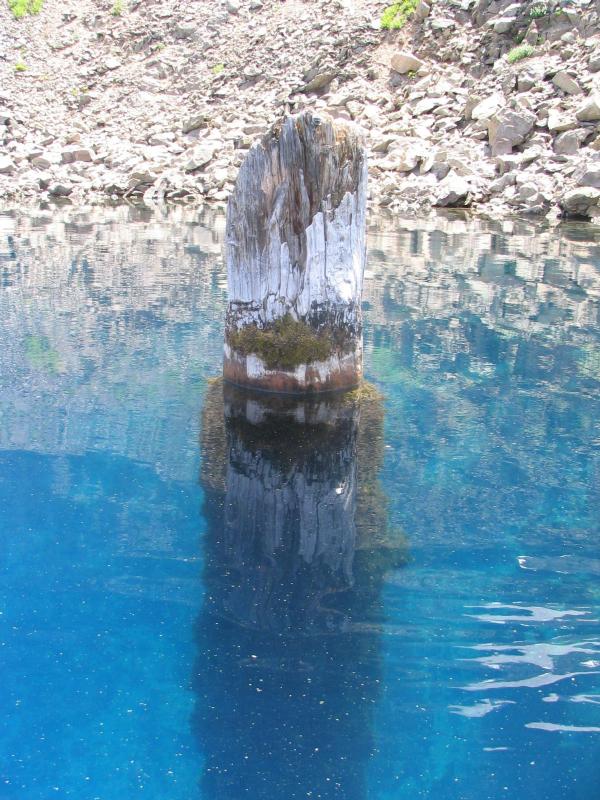Old Man of the Lake on:
[Wikipedia]
[Google]
[Amazon]
 The Old Man of the Lake is a tall tree stump, most likely a hemlock, that has been bobbing vertically in
The Old Man of the Lake is a tall tree stump, most likely a hemlock, that has been bobbing vertically in
 The Old Man of the Lake is a tall tree stump, most likely a hemlock, that has been bobbing vertically in
The Old Man of the Lake is a tall tree stump, most likely a hemlock, that has been bobbing vertically in Oregon
Oregon () is a U.S. state, state in the Pacific Northwest region of the Western United States. The Columbia River delineates much of Oregon's northern boundary with Washington (state), Washington, while the Snake River delineates much of it ...
's Crater Lake since at least 1896.
The stump is about in diameter at the waterline and stands approximately above the water. Its surface has been bleached white due to photodegradation. The exposed end of the floating tree is splintered and worn but wide and buoyant enough to support a person's weight.
''Fontinalis
''Fontinalis'' is a genus of submerged aquatic mosses belonging to the subclass Bryidae
Bryidae is an important subclass of Bryopsida. It is common throughout the whole world. Members have a double peristome with alternating tooth segments. ...
'', a moss
Mosses are small, non-vascular flowerless plants in the taxonomic division Bryophyta (, ) '' sensu stricto''. Bryophyta ('' sensu lato'', Schimp. 1879) may also refer to the parent group bryophytes, which comprise liverworts, mosses, and ...
present in the waters of Crater Lake at a depth of , also grows on the Old Man of the Lake, the only place the moss is found near the surface.
History
Joseph S. Diller published the firstgeology
Geology () is a branch of natural science concerned with Earth and other Astronomical object, astronomical objects, the features or rock (geology), rocks of which it is composed, and the processes by which they change over time. Modern geology ...
of Crater Lake in 1902, the same year the area became a national park
A national park is a natural park in use for conservation purposes, created and protected by national governments. Often it is a reserve of natural, semi-natural, or developed land that a sovereign state declares or owns. Although individual ...
. In his work, Diller briefly describes a great stump he had found in the lake six years earlier, in a report dated 1896. Preliminary carbon dating
Radiocarbon dating (also referred to as carbon dating or carbon-14 dating) is a method for determining the age of an object containing organic material by using the properties of radiocarbon, a radioactive isotope of carbon.
The method was de ...
of the stump has suggested that the tree itself is at least 450 years old.
Diller established that it could travel by tying baling wire around it and pulling it a short distance. Five years later, Diller observed the Old Man to be from the location he had previously noted. The earliest known photograph of the trunk dates to this period.
As the result of an inquiry from Washington, D.C., the project of recording the Old Man's location was undertaken between July 1 and September 30, 1938. Those observations indicated that it travels quite extensively, and sometimes with surprising speed. During the period of observation in 1938, the Old Man traveled at least . The greatest movements occurred on days of high wind and waves.
Since it can be virtually anywhere on the lake, boat captains commonly communicate its position to each other as a general matter of safety although private boating is prohibited on Crater Lake today.
In 1988, submarine explorations were conducted in the lake, and the scientists decided to tie the Old Man off the eastern side of Wizard Island
Wizard Island is a volcanic cinder cone which forms an island at the west end of Crater Lake in Crater Lake National Park, Oregon. The top of the island reaches above sea level, about above the average surface of the lake.
The cone is capp ...
to neutralize the navigational hazard until their research work was complete. Upon immobilizing the log, the weather went from clear to stormy. After it started snowing in August, they released the Old Man. Soon after, the weather cleared up, encouraging superstitions.
, tour boats regularly pass the Old Man on their journeys to view the sights around Crater Lake. Due to the lake's water clarity, the entire submerged section of the tree's trunk can be seen below the waterline.
See also
*List of individual trees
The following is a list of notable trees. Trees listed here are regarded as important or specific by their historical, national, locational, natural or mythological context. The list includes actual trees located throughout the world, as well as ...
Further reading
* "The geology and petrography of Crater Lake National Park" by Joseph Silas Diller and Horace Bushnell Patton. .S. Geological Survey Professional Paper No. 3. Series B, Descriptive geology, 22. Series D, Petrography and mineralogy, 21.References
External links
* {{coord, 42.95, -122.10, display=title Natural history of Oregon Individual trees in Oregon Crater Lake